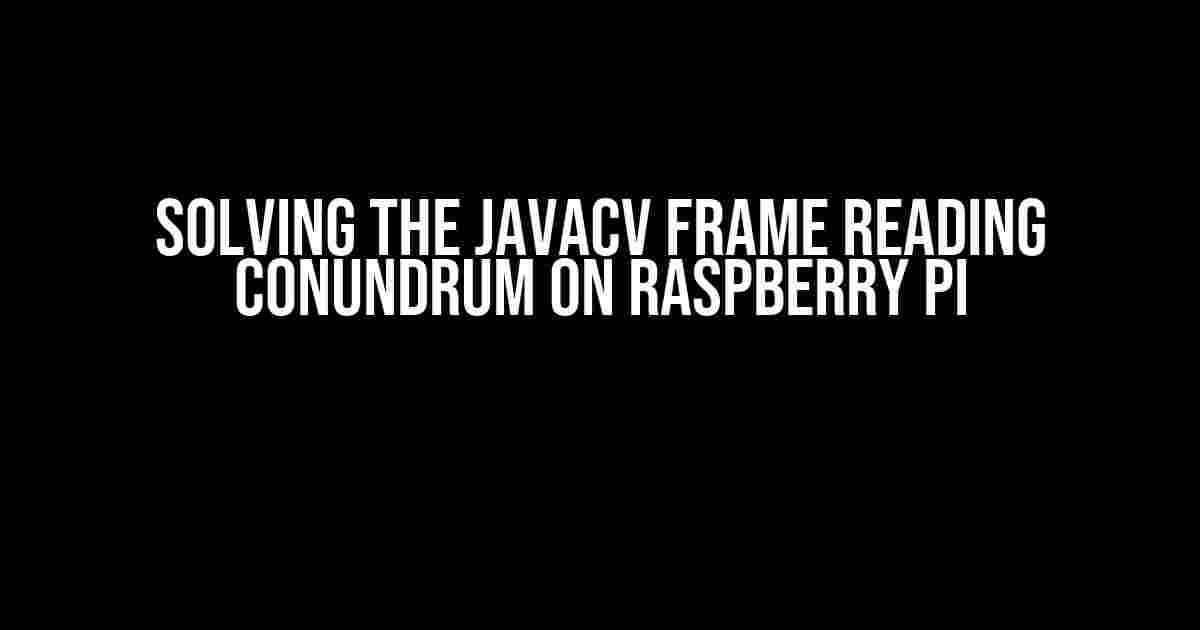Are you tired of struggles with JavaCV frame reading on your Raspberry Pi? You’re not alone! Many developers have fallen victim to the frustrating issues that come with trying to get JavaCV to work seamlessly on this popular single-board computer. But fear not, dear reader, for today we’re going to tackle this problem head-on and emerge victorious!
What is JavaCV?
JavaCV is a Java wrapper for OpenCV, a powerful computer vision library. It allows developers to tap into the vast capabilities of OpenCV using the familiar Java programming language. JavaCV provides a convenient way to capture and process video frames, making it an ideal choice for various applications, including robotics, surveillance, and more.
The Problem: JavaCV Frame Reading Not Working on Raspberry Pi
So, why does JavaCV frame reading fail to work on Raspberry Pi? The answer lies in the unique architecture of the Raspberry Pi. This tiny computer uses an ARM processor, which requires a different set of libraries and configurations compared to x86-based systems. As a result, JavaCV’s default settings may not be compatible with the Raspberry Pi’s environment, causing frame reading issues.
Cause 1: Incorrect OpenCV Version
One common mistake is using an OpenCV version that’s incompatible with the Raspberry Pi’s ARM architecture. Make sure you’re using OpenCV 3.4.10 or later, which includes support for ARMv7l.
Cause 2: Missing dependencies
Raspberry Pi’s Raspbian OS might not have all the required dependencies installed by default. You’ll need to add the following packages to your system:
- libopencv-java
- libopencv-dev
- libdc1394-22-dev
Install these packages using the following command:
sudo apt-get install libopencv-java libopencv-dev libdc1394-22-devSolution: Configure JavaCV for Raspberry Pi
Now that we’ve identified the potential causes, let’s get our hands dirty and configure JavaCV to work with your Raspberry Pi!
Step 1: Set the OpenCV Library Path
Update your JavaCV code to include the correct OpenCV library path:
System.setProperty("java.library.path", "/usr/lib/jni/");This tells JavaCV to look for the OpenCV libraries in the correct location.
Step 2: Load the OpenCV Native Library
Load the OpenCV native library using the following code:
nu.pattern.OpenCV.loadLocally();This step ensures that JavaCV can communicate with the OpenCV native library.
Step 3: Initialize the Camera
Initialize the camera using the following code:
FrameGrabber grabber = new OpenCVFrameGrabber(0);
grabber.start();This code sets up the camera and prepares it for frame reading.
Step 4: Read Frames
Now, you can read frames from the camera using the following code:
Frame frame = grabber.grab();
if (frame != null) {
// Process the frame
System.out.println("Frame read successfully!");
} else {
System.out.println("Error reading frame!");
}This code reads a frame from the camera and checks if it’s valid. If the frame is read successfully, you can process it further.
Troubleshooting Tips
If you’re still facing issues, try the following troubleshooting tips:
-
Verify that your Raspberry Pi’s camera is properly connected and configured.
-
Check the JavaCV version and ensure it’s compatible with your OpenCV installation.
-
Review your code for any errors or typos.
-
Try using a different frame grabber, such as the FFmpegFrameGrabber.
Conclusion
Voilà! With these steps, you should now be able to read frames from your Raspberry Pi’s camera using JavaCV. Remember to be patient and persistent while troubleshooting, as the process can be time-consuming. But with the right configuration and troubleshooting, you’ll be capturing and processing frames like a pro!
| Resource | Description |
|---|---|
| JavaCV GitHub | The official JavaCV repository on GitHub. |
| OpenCV Documentation | The official OpenCV documentation, featuring tutorials and guides. |
| Raspberry Pi Official Documentation | The official Raspberry Pi documentation, covering setup, configuration, and more. |
We hope this comprehensive guide has helped you overcome the JavaCV frame reading issues on your Raspberry Pi. Happy coding!
Here are 5 questions and answers about “JavaCV frame reading not working on Raspberry Pi” in a creative voice and tone:
Frequently Asked Question
Got stuck with JavaCV frame reading on your Raspberry Pi? Don’t worry, we’ve got you covered!
Q1: Why is JavaCV frame reading not working on my Raspberry Pi?
This might be due to the Raspberry Pi’s ARM architecture, which requires a specific build of JavaCV. Make sure you’re using the correct version of JavaCV compiled for ARM.
Q2: How do I install the correct version of JavaCV on my Raspberry Pi?
You can install JavaCV using Maven or Gradle by adding the correct dependency to your project. Alternatively, you can download the pre-compiled ARM version of JavaCV from the official GitHub repository.
Q3: What are the system requirements for running JavaCV on Raspberry Pi?
Your Raspberry Pi should have at least 2GB of RAM and run Raspbian OS (preferably the latest version). Additionally, ensure that you have the necessary dependencies installed, such as OpenCV and FFmpeg.
Q4: How can I troubleshoot JavaCV frame reading issues on my Raspberry Pi?
Check the JavaCV logs for errors, and ensure that your code is correctly initializing the camera and reading frames. You can also try using a different camera or updating your OpenCV and FFmpeg versions.
Q5: Are there any alternative libraries to JavaCV for frame reading on Raspberry Pi?
Yes, you can use other libraries like OpenCV’s Java wrapper, Pi4J, or even Python’s OpenCV library with Jython. However, JavaCV is a popular choice for its ease of use and flexibility.


